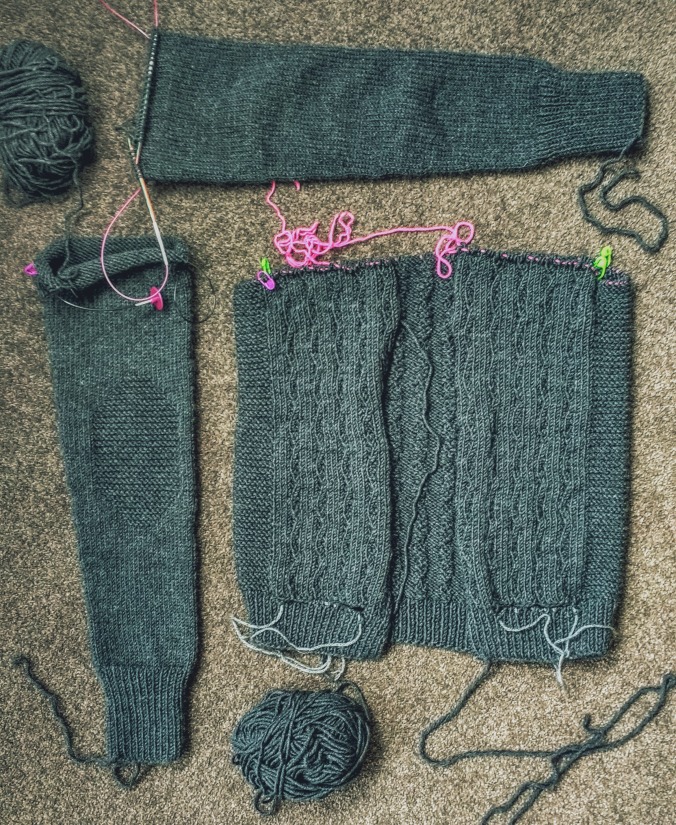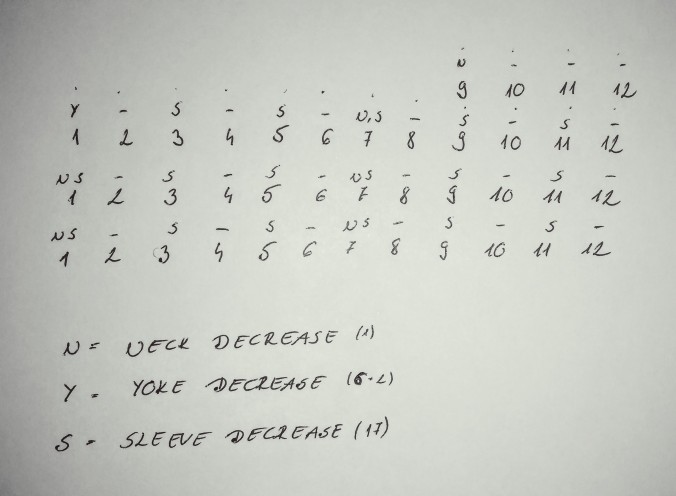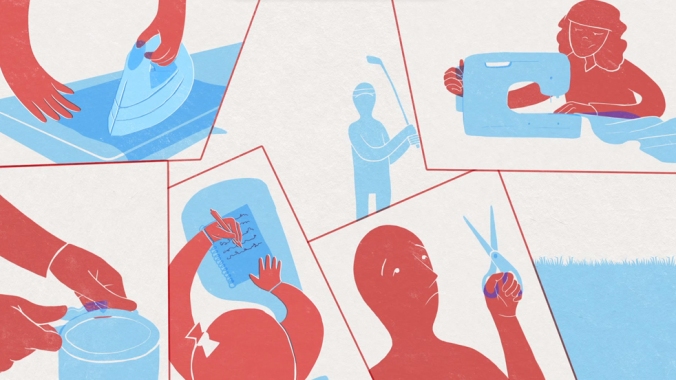Yuppie! The Coda sweater is finished! This was my second ever pullover, and man it took some patience… To think I got started on it during our Christmas holiday in Tenerife, and thought I would finish it on the flight here to New Zealand… At least, now I have various reasons to be proud of myself:
- This was a stash-decreasing project, where I had to deliberately find a pattern to use yarn originally designated to become something else. Eight skeins put to good use, check.
- I had a limited amount of yarn to work with, which meant I had to go especially stingy. I skipped the tubular cast on (which is a pity) and I actually had to re-knit and shorten the sleeves. Ripping, check.
- More re-knitting was required for the back, as I was not able to perform an acceptable seam at the centre of the back cable. More ripping, check.
- I mastered the much dreaded kitchener stitch and wrap and turn short rows. New skills, check.
- In order to find an alternative solution for the back cable, I contacted a previously unknown fellow-knitter on Ravelry (see more on this below). Stalking/socializing, check.
Given that I think the reworking of the back cable might be useful for other knitters, I’ll try to give an account based on my scarce (I know… 😦 ) notes. Before that, I would like to thank Muriel (Ravelry user princessemumu) for her kind help, her Coda looks just wonderful! – I think much better than mine.
And with that, ladies and gentlemen, I present you…
The reworked Coda back cable
Disclaimer: I do not think this is the Holy Grail of Coda backs, but it did work for me. Please read through before deciding to go for it. Also, there may be errors in my math, but I think you’ll get the general idea and hopefully anyone who decides to try this solution, will be able to work it out.


The main idea is simple: In order to avoid the seaming the cable at the centre , it is worked as a single cable from the right side of the back to the left side. This means that the part of original pattern called Back (Convex arch shaping) has to be reworked. The way I did this is the following.
Centre convex shape in stockinette stitch
The original pattern instructs us to start knitting the stockinette section between the cables together with the right and the left cables, using some short row shaping, which essentially serves for us to be able to knit more rows of the cable, which will give the curve on both sides. What I did was to set aside the stitches for the cables, and work the stockinette section separately.
From the stitches held for the back, put 16 stitches counting from the right edge and 16 stitches counting from the left edge on waste yarn. You are going to work only the centre stitches, whose number must be [number of held stitches] – 32. So if you are working size 37, as I did, you’ll have 71-32 = 39 stitches on your needle for this section. Join the working yarn on the left side, starting to knit a wrong side row.
Setup row (WS): Purl all stitches.
Row 1 (RS): SSK, knit to last to stitches, k2tog.
Row 2 (WS): P2tog, purl to last to stitches, SSK.
Repeat rows 1 and 2 two more times. You will have worked six decrease rows all together, and decreased 12 stitches. So, again, if you are knitting size 37, you will have 39-12 = 27 stitches left on the needle.
Starting the cable
Now you are going to start knitting the cable, running from the right side of the back to the left side. The first rows and the last rows will not be joined to the centre section you have just knitted, you will seam them together later.
Turn your work to the wrong side, shifting the stitches you have just worked to the needle. Now, pick up the 16 stitches you set aside for the right cable. They should be on the left needle with the wrong side facing, as you are going to start knitting with a wrong side row, placing a marker to separate the cable and the stickinette stitches. If you feel lost, just transfer the stitches from the previous section on a waste yarn, and work only with the 16 cable stitches on the needles for now.
You will be joining new yarn to work the cable starting with a wrong side row. You will be working the first set of short rows over the cable, as described in the pattern, only, you’ll only knit the part concerning the first 16 stitches and Chart A.
Setup row (WS): P2tog, YO, purl 1, knit 2, purl 9, knit 2.
Short row 1 (RS): Work Chart A across first 12 stitches, wrap and turn.
Short row 2 (WS): Work last 12 stitches of Chart A.
Row 3: Work Chart A to the end, working the wrap together with the wrapped stitch).
Row 4: Work Chart A.
Work rows 1-4 two more times.
Joining the cable with the stockinette section
If you put the stitches from the centre stockinette section on hold, now is the time to put them back on the needle. You will have all the stitches (stockinette section + 16 stitches for the cable) on the left hand needle, right side facing. If you have not done so, place a marker between the cable and the stockinette stitches.
You will start with working the section called Right Side Arch in the original pattern, as is, only you will not break your working yarn once you get to the centre of the stockinette section, but keep knitting. You will have to decrease all the stitches into the cable in the following way.
The original pattern instructs you to repeat short rows 21 and 22 of the Right Side Arch section a certain amount of times, but you will repeat them twice as many + one time. So, once again, if you are knitting size 37, you are instructed to repeat these rows a total number of 8 times, but you will do 2*8 = 16 repeats. By the time you are finished, you should have 6 stitches left from the centre stockinette section that have not been decreased into the cable.
Now what is left to do, is to replicate the beginning of the Right Side Arch section, only in the reverse, that is:
Short row 1 (RS, Decrease row): Work Chart A to marker (working wrap together with wrapped stitch-if any), slip marker, SSK, turn.
Short row 2 (WS): Slip 1 wyif, slip marker, work Chart A to the end.
Short row 3: Work Chart A across next 12 stitches, wrap and turn.
Short row 4: Work last 12 stitches of Chart A to end.
Repeat rows 1-4 four more times.
By this end of this section, 17 stitches should remain (16 cable stitches + 1 stitch).
Finishing the cable
To finish the cable, you will have to replicate the first short row section, again, in the reverse. On the first row, knit the last remaining stitch from the centre together with the last stitch of the cable (or SSK?).
Short row 1 (RS): Work Chart A to the end, working the wrap together with the wrapped stitch), and knitting the last stitch (or SSK?) together with the last stitch of the centre stockinette section (this needs to be done only on the first repeat).
Short row 2 (WS): Work Chart A.
Short row 3: Work Chart A across first 12 stitches, wrap and turn.
Short row 4: Work last 12 stitches of Chart A.
Repeat rows 1-4 two more times. Only the 16 stitches from the cable should remain.
Turn to the wrong side, and purl across the 16 stitches.
Finishing up
Join the remaining 16 stitches with the 16 stitches you set aside at the beginning on the left back using kitchener stitch.
To close the gap between the cable and the centre stockinette section, stitch the two together, imitating the SSK stitches with the sewing strand (I wish I had made notes or photos as to how I did this…). This will be easier at the right back, as the decreases are already in the correct direction, but at the left back they are the opposite. I know this is not perfect, but at least it is at the sides of the back and not that visible. Better solutions are welcome.
—————–
Pattern: Coda by Olga Buraya-Kefelian, BT Wool People Vol. 7
Yarn: 9 skeins of Drops Aplaca (held double) in Dark Lime
Needles: 4.5 mm (US 7) for the ribbing and 5 mm (US 7) for the body (knitted size 37)


